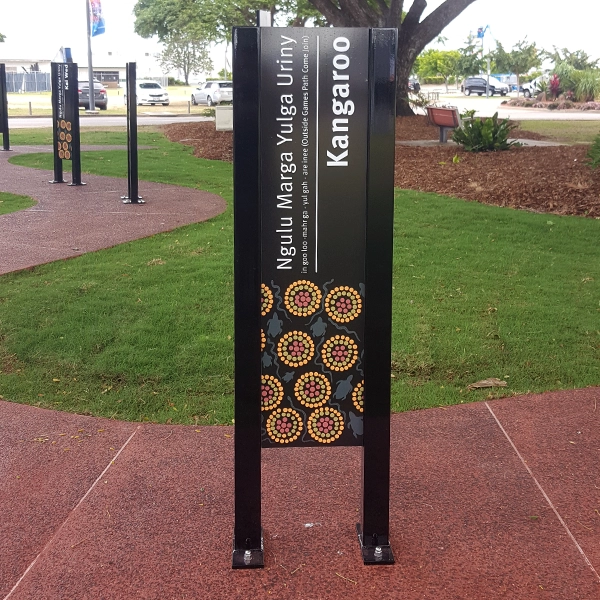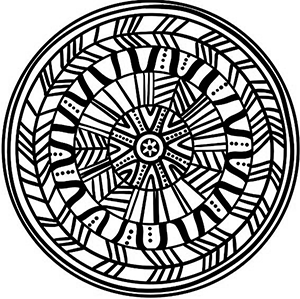Ngulu Marga Yulga Uriny - Games Trail
Ngulu Marga Yulga Uriny
 Pronunciation: 'in-goo-loo mahr-ga yul-gah are-inee'.
Pronunciation: 'in-goo-loo mahr-ga yul-gah are-inee'.
Meaning: "outside games path, come join in."
Explore the Ngulu Marga Yulga Uriny Games Trail to find out about traditional games that were played by Aboriginal and Torres Strait Islander children in many different parts of North Queensland. Try out the games with your family and friends and have fun.
These eight games were used as learning tools for Aboriginal and Torres Strait Islander children to develop their skills for later in life.
The words ngulu marga yulga uriny come from the local Wulgurukaba language of Townsville:
- ngulu means 'outside'
- marga means 'games'
- yulga means 'path'
- uriny means 'come join'.
The trail is located near the Sporting Drive roundabout at Riverway, on the traditional land of the Wulgurukaba people.
Visit the Australian Sports Commission's Yulunga: Traditional Indigenous Games page to search all games from the research.
Birray
Pronunciation: 'bir-ray'.
Bands of learning: kindergarten to year 3.
Background
Young children in the Bloomfield area of North Queensland played the game of birray (march-fly). It was observed by Walter Roth in the early 1900s.
Language
The name of the game, birray, is taken from the Wik‑Mungkan language of North Queensland.
Short description
This is a game where a chaser (birray) attempts to tag (touch) other players.
Players
A group of four to eight players.
Playing area
A suitable designated area free of obstructions.
Gameplay and Basic Rules
- Players spread out around the playing area.
- Shutting their eyes (or blindfolded) the player who takes the part of the birray (march-fly) runs about trying to catch (touch) another player in the group.
- As soon as the player is successful, they make an unpleasant noise (imitating the insect’s buzz) near the ear of the player caught and give them a ‘pretend’ pinch (indicative of the sting).
- The player caught (touched) becomes the new birray and the game continues.
Suggestion
This game is recommended for younger children.
Teaching Points
- "Spread out."
- "Keep moving. Watch out for the birray."
- "Look out for other players."
- "Caught. Change over. Let’s go again."
Edor
Pronunciation: 'e-dor'.
Banks of learning: year 4 through to post-school age.
Background
This version of a chasing-and-tagging game originates in the Aurukun Aboriginal community and has been popular and played for as long as most can remember.
This game has been frequently played around the streets, in the school at break time and before physical education lessons as a fun warm-up activity.
The enthusiasm and vigour that the players display (all the while conversing freely in the local language of Wik-Mungkan) is a joy to watch and a clear indication of the vibrant strength of the traditional culture still evident in this community today.
The game was observed by Troy Meston and is presented on the authority of Aunty Cathy (local Elder and Aurukun Community School Teacher’s Aide). Edor has been played since she was a child and well before.
Language
The names edor, idor, ida or ‘the running game’ have all been used to refer to this game. The term edor has been commonly used in the North Queensland and Torres Strait regions.
Short Description
Edor is a goal-orientated, chasing-and-tagging game for a large group of players.
Players
- A large group of players can play.
- Players are divided into two teams.
Playing Area
A football field or other open area suitable to the activity.
Equipment
Assign ‘goals’ at opposite ends of the playing area by using a large tree or other structure.
Gameplay and Basic Rules
- Players assemble in the middle of the playing area.
- All the organisation and discussion related to the game is left to the players.
- Players decide on the teams, the goals, the direction in which teams will run and who will start.
- A player is selected as the Edor and this player is given five seconds before they take off, running towards the goal.
- A player who is the Edor attempts to reach his or her designated goal at the end of the playing field.
- The player attempts to do this without being tagged (touched) by a player from the opposing team.
- To become the Edor a player of the defending team tags the player who was the Edor.
- This player then runs towards his or her designated goal at the other end of the playing area.
- The direction of the game changes each time a tag is made on the Edor.
- The game continues until a player is successfully able to reach the goal.
- When a player reaches the goal his or her team wins the round, and all players meet in the centre of the field to start a new game.
- Players are not allowed to interfere with each other or to stand in front of or near the goal to stop the Edor.
- These actions are not seen to be in keeping with the intention of the game.
- If necessary, a 5–15 metre semi-circle can be marked in front of the goal.
Variations
- In part of the Torres Strait region, the game is played on the beach using two trees up to 0 metres apart. One selected player starts by running towards one tree to try and touch it. If they are touched by another player this player calls out loudly, ‘Ida’, and starts running towards the tree that is the longest distance away. Continue in this way.
- Edor can be played as a competition, with one point for each successful goal.
- Tag-team Edor: To avoid being tagged by the opposition the Edor may pass the tag to a teammate in the hope of him or her reaching the goal. Play with a maximum of three tags for a team. The Edor must be tagged (touched) three times by different players from the other team. When the third tag has been made the new Edor is the player who made the last tag.
- Introduce a ball for the Edor to carry and once they are tagged the player must release the ball to allow the tagger a chance to pick it up and run with it. A combination of the three-tag rule can be integrated as well as passing the ball in any direction to another player on the same team.
Comment
There is some evidence that a form of this game was introduced to northern parts of Australia through missionaries from Samoa in the early 1900s. The game has elements of both individual and team play.
Suggestion
A method of starting the game is to have all the players close their eyes and someone is designated to discreetly select the player to be the Edor. Once selected a countdown of five seconds is given before the Edor must commence running.
Safety
Thoroughly survey the playing area prior to the start of the game to remove any potentially dangerous obstructions. Enforce that a tag (touch) is made with minimum force and is not a slap or a punch — demonstrate the acceptable form for players to replicate.
Teaching Points
- "Teams ready. Who is starting?"
- "Edor ready. Go."
- "Run. Tag and change."
- "Change. Keep going. Run hard. Chase them."
Gitja
Pronunciation: 'git-ja'.
Bands of learning: kindergarten to year 3.
Background
The Gitga (moon) play game from the North Queensland area was usually played when a number of children gathered together. The full version of the game observed involved imitation and acting aspects along with a running-and-chasing activity.
Language
Gitga was the Koko-yellanji (Kuku-Yalanji) language term signifying the moon.
Short description
This is a chasing-and-catching (tag) game. It is a simplified version of a more involved game.
Players
A group of 10–14 or more players.
Playing area
A designated area suitable for the activity.
Gameplay and Basic Rules
- In this game a player takes the part of Gitga.
- Players form a circle around a player with Gitga on the outside and another player on the inside of the circle.
- The player in the circle represents someone who has eaten Gitga’s food by mistake and Gitga wants him or her to know it was the wrong thing to do.
- The game starts and Gitga attempts to catch (touch) the player who is in the middle of the circle.
- The players in the circle hold hands to attempt to ‘stop’ the Gitga and to help the player being chased.
- The Gitga may not break through the arms but can duck under them to chase.
- The players in the circle bend down to stop the Gitga.
- Players allow the player in the middle to go outside the circle and back into it as the middle player is chased by Gitga.
- Play continues until Gitga has succeeded in catching (touching) the player or a set time expires.
- The players must stay within the designated playing area when running and chasing.
Variation
Play with two people to be chased by Gitga.
Comment
This version is shortened from a full game of Gitga and does not include the acting and playing aspects. However, it still reflects the basic nature of the game.
Teaching Points
- "Form a circle. Player inside, Gitga outside."
- "Hold hands. Do not break through the arms."
- "Duck under."
- "Keep going. Help the runner. Cheer for them."
- "Good. Change over. Well done everyone.
Kai
Pronunciation: 'kai'.
Bands of learning: years 4 and up through to post-school age.
Background
In this game from the Torres Strait Islands, a number of players stood in a circle and sang the kai wed (ball song) as they hit a ball up in the air with the palms of their hands. The game was played using the thick, oval, deep-red fruit of the kai tree, which is quite light when dry.
Language
Kai wed, also used as kamut wed for string-figure ‘ball playing’.
Kai tupitare abukak
kai o atimed kak kai oBall strike without dropping it —
ball throw not the ball.kai wed (ball song)
Short description
This is a hand-hitting (volley) game in which players attempt to keep the ball in the air as long as they can.
Players
Groups of four to eight players.
Playing Area
A designated indoor or outdoor area suitable for the activity.
Equipment
A tennis ball, small beach ball, paketa or a small, soft ball.
Gameplay and Basic Rules
- Players form a circle.
- The ball is thrown into the air, and each player passes it to another by striking the ball upwards with the palm of the hand.
- The ball is usually passed around the circle (players at least 1.8 metres apart) but the game can be played by hitting to any player in the circle other than the one next to the player.
Scoring
- In a team contest, the game is won by the group that is able to keep the ball going the best and does not allow it to hit the ground.
- If the ball hits the ground while attempting to achieve a designated target score, continue the score.
Variations
Group Kai
- Use a sponge ball, beach ball or other light ball.
- Players hit the ball — with hands and arms only — around the playing area (30 metres x 15 metres) to each other or divide into two teams and attempt to hit (volley) the ball past the baseline (or a wall) to score.
- After a score the ball is hit back to the other team to continue play.
- Only one hit at a time is allowed for players in general play.
- No physical contact is allowed.
- Allow players to make two contacts (one to control the ball and one to hit it).
Team Kai
- This can be played as a cooperative game in which players as a group attempt to make as many hits as they can without missing.
- Players stand in a circle about 1 metre apart.
- One player throws the ball into the air, and the players take turns hitting it upwards with the palm of one hand.
- They may not catch the ball but must keep their hands open and flat.
- A player may not hit the ball twice in a row.
- Players may sing a song or recite the alphabet as they play (one letter for each hit).
- The ball must be hit to at least head height for younger players and at least 1 metre above head height for more experienced or older players.
- When the ball hits the ground, the game is restarted.
- The game can be played with the players taking turns in a set order, random hitting (with the ball not hit by the same player twice in a row), or individual players attempting to hit the ball the greatest number of times.
Individual Contest or Practice Kai:
- Players compete to see who can hit the ball into the air (above head height) with their hand the greatest number of times without it hitting the ground.
- This can be played using either hand, alternating, or combined with other stunts/skills such as through the legs, etc.
Suggestion
- Use as a practice activity for sports such as tennis, touch football, Australian rules football, volleyball and speedball.
- In a physical education class the game can be played with a number of modifications as part of a hitting-skill activity. Progressions are:
- Players hit the ball around in a circle (either direction).
- Players hit the ball to other players who call out their name. Attempt to work through the whole team.
- Players work as a team to hit the ball in the air and go through the letters of the alphabet. No player is allowed to touch it twice in succession or receive it straight back from another player.
- Give each player a number and work through the numbers in a set order.
- One player stands in the middle of the circle and the ball is deflected to the other players who in turn hit it back to the middle player. Change the middle player each time any player makes an error. The aim is to keep the centre player in as long as possible.
Teaching Points
- "Players in a circle. Palms of hand up. Hit to start."
- "Hit to different players."
- "Hit and move back out of the way."
- "Count the volleys. Keep going. Let’s start again."
- "Good work. Call for the ball."
- "Watch out for each other."
- "Direct the ball to another player."
Kalkadoon Kee’an
Pronunciation: 'kal-ka-doon kee-an'.
Bands of learning: all ages
Background
In areas of north Queensland, a game of throwing skill was played. A large bone, such as an emu shinbone (with twine attached to it) was thrown over a net (used to catch emus) into a pit or hole. Considering the distance to the hole, great skill was required to correctly aim the bone and ensure that it did not touch the net.
Language
The game is called kee’an, which means 'to play' in the Wik-Mungkan language of North Queensland. The Kalkadoon people from around the Mount Isa area also played a game similar to the one outlined and their connection has been recognised as part of the name of this game.
Short description
This activity involves throwing a ball into a small bin target as many times as possible, as part of a tabloid activity or a skill game.
Players
Play singly or in groups of two to four players.
Playing area
A designated indoor or outdoor area suitable for the activity.
Equipment
- Use ‘foxtail’ or a tennis ball in a stocking (or long football sock) as the bone, with twine attached. When a ball in a stocking is used the length of the foxtail may be adjusted.
- Use a large plastic bin or hoop as the pit or hole.
Gameplay and Basic Rules
- Players in groups of two to four line up behind one another.
- Players hold the foxtail a short distance away from the ball and take it in turns to attempt to throw the foxtail ball into a small bin from 3–5 metres away.
- To avoid interference, the player throwing the foxtail is 2 metres in front of the rest of the line of players (mark a line for this).
- As an extra challenge the balls are held further down the tail.
- Players retrieve the ball after their turn and give it to the next player.
Scoring
- The game is usually played for fun and recognition for a successful throw, but players can keep a team score from a set time (2–3 minutes) or set number of turns (four to six).
Variations
- Players throw into a hoop 3–5 metres in front of them. They score one point if it touches or bounces in and out of the hoop and two points if it stays in the hoop. A group score can be used. (Suitable for younger players.)
- Players have a set number of turns (for example, five) before the next player in line has a turn. Either play a competition between individual players or groups or add all the individual scores together for a class total.
Teaching Points
- "Form a line."
- "Player in front with the foxtail."
- "Thrower ready. Go."
- "Good throws."
- "Watch the target."
- "Point your hand and follow through."
- "Collect the ball."
- "Next player move up and ready."
- "Go to end of line. Keep going."
Kangaroo
Pronunciation: 'kang-a-roo'.
Bands of learning: all ages
Background
Imitation activities were a favourite and popular activity for children everywhere. In one activity children would copy the actions of the kangaroo.
Language
The word kangaroo appears to have originated from the word gangarru in the language of the Gouguyimithirr (Guugu Yimithirr) people in the Wahalumbaal (Endeavour River) area of North Queensland.
Short Description
A jumping relay race based on the actions of a kangaroo jumping.
Players
Teams of four to eight players.
Playing Area
An appropriate area with lines about 10–15 metres apart.
Gameplay and Basic Rules
- This simple relay game is conducted over a distance appropriate to the age group of the players.
- The players jump or bound (hop) like kangaroos, keeping their legs together.
- They hold their arms close to their bodies at waist to chest level and with hands pointing down.
- They jump in long strides using an up and down motion.
Variations
- Players step and hop — ‘hippety hop’ — or gallop step.
- Place a large ball between the legs and hop.
- The relay course could include an obstacle to climb over or could be a winding rather than a straight path.
- Have races between pairs of groups of players.
- Players line up next to each other and all hop together past a line 10–15 metres away.
- On mats and over low hurdles.
Teaching Points
- "Teams line up. Ready."
- "Arms up, feet together. Go."
- "Feet together. Hop."
- "Keep going."
- "Allow player to hop then one step, hop on two feet then step again."
Koabangan
Pronunciation: 'ko-a-ban-gan'.
Bands of learning: kindergarten to year 6.
Background
A game called koabangan was a finding-object game observed being played in the early 1900s by the Kokomini boys of North Queensland. The object commonly used was a goanna claw, but other objects were also used.
Short Description
A player hides an object in a designated area and the other players attempt to find it.
Players
A group of four or more players.
Playing Area
A designated outdoor area suitable for the activity.
Equipment
- An object such as a tennis ball or a paper clip for a goanna claw
- A number of short bushy trees are required. (If this is not suitable then other areas can be used to hide the object).
Gameplay and Basic Rules
- The players sit in a circle with their heads low and hands over their faces.
- One player hides the object somewhere in the playing area.
- On a signal being given by the ‘hider’ the players jump up and start looking for the hidden object.
- The idea is to be the first to find the object within a set time.
- The player finding the object has the next turn.
Variations
- Use a number of different objects.
- Restrict the size of the playing area.
- Players are blindfolded.
- Play in an indoor hall or similar using a tennis ball to hide.
Comment
This game is suggested for younger children.
Teaching Points
- "Close your eyes. Hide the marble."
- "Keep looking."
- "Find it. Are we ‘hot’ or ‘cold’?"
- "Well done. Change over and we start again."
Marn-grook
Pronunciation: 'marn-grook'.
Bands of learning: years 4 to 12.
Background
The marn-grook or ‘game of ball’ was played by some Aboriginal groups in Victoria. The men and boys would joyfully assemble when the game was to be played. The ball was often made of twine formed using the twisted hair of the possum. It was of a good size, somewhat elastic but firm and light.
The ball was given to the ‘best’ player or someone of ‘note’ to commence the game. The tallest players, and those able to jump the highest, had the best chances in the game. Some players would leap as high as 1.5 metres (or higher) from the ground to catch the ball. The game continued for hours and the players never seemed to weary of the exercise.
Some people believe that the game of marn-grook influenced the development of Australian rules football, but the evidence is not conclusive.
Short description
A ball is kicked into the air and players attempt to catch it. This version is designed for younger players.
Players
Groups of six to 12 players.
Playing area
A designated area suitable for the activity. If the ball goes outside the area the game is stopped.
Equipment
A small soccer ball, gator skin ball or volleyball.
Gameplay and basic rules
- The ball is dropped and kicked high into the air using the instep of the foot.
- Players then attempt to secure the ball.
- The player who takes possession of the ball kicks it in the air and again a scramble for the ball ensues.
- Players may not dive on the ball on the ground to secure it and must try to avoid physical contact as much as possible.
- It is usual for the players to attempt to catch the ball, but if it is knocked or dropped to the ground by players it is still in play.
Variations
- Players are in groups 15–20 metres apart. When a player catches the ball, they kick it towards the other group of players, who attempt to catch the ball. This works very well as a lunchtime or physical education class skill activity.
- Fast play. Use a number of light balls. One or two designated players kick balls high into the air for other players to chase and gather. The balls are handed back to the kickers and play continues in this manner. Change around kickers and observe safety factors — the kickers should kick balls in different directions. If players catch the ball without it hitting the ground or after it bounces, they are acknowledged.
Safety
Restrict the amount of physical contact. Stop the activity immediately if safety is compromised.
Teaching points
- "Spread out. Ready."
- "Kick it high. Drop the ball to foot and kick."
- "Call for the ball. No contact."
- "Good catch. Let them kick."
- "Keep going."
Acknowledgments
Townsville City Council acknowledges the Wulgurukaba of Gurambilbarra and Yunbenun, Bindal, Gugu Badhun and Nywaigi as the Traditional Owners of this land. We pay our respects to their cultures, their ancestors and their Elders, past, present, and all future generations.
Ngulu Marga Yulga Uriny Games Trail
The Ngulu Marga Yulga Uriny Games Trail was unveiled on 10 April 2018 as part of the Gold Coast 2018 Commonwealth Games (GC2018) Reconciliation Action Plan legacy project. This permanent installation of interpretive signage showcases traditional games played by Aboriginal and Torres Strait Islander children in many different parts of North Queensland.
The project was a collaboration between Townsville City Council, the Queensland Government’s Office of the Commonwealth Games (OCG), the Queensland Department of Housing and Public Works (Sport and Recreation Services), and Nature Play Queensland.
The artwork on the signage was courtesy of Juru artist Kelvin Lampton.
For more information read:
Yulunga Traditional Indigenous Games
All traditional Aboriginal and Torres Strait Islander games have been sourced from Yulunga: Traditional Indigenous Games (Australian Sports Commission, 2009) and used with the permission of the Australian Sports Commission.
Townsville City Council acknowledges Ken Edwards for the extensive and thorough research undertaken to collate the Yulunga: Traditional Indigenous Games.
To create this resource, Ken Edwards with the assistance of Troy Meston reviewed almost every available account of games from Aboriginal and Torres Strait Islander people across all parts of Australia.
The Australian Sports Commission recognises the traditional owners of the games and activities that formed the basis of this resource. This resource is dedicated to all Aboriginal and Torres Strait Islander people.
Yulunga means playing in the language of the Kamilaroi (Gamori) people of northern-western New South Wales.
For more information visit:









